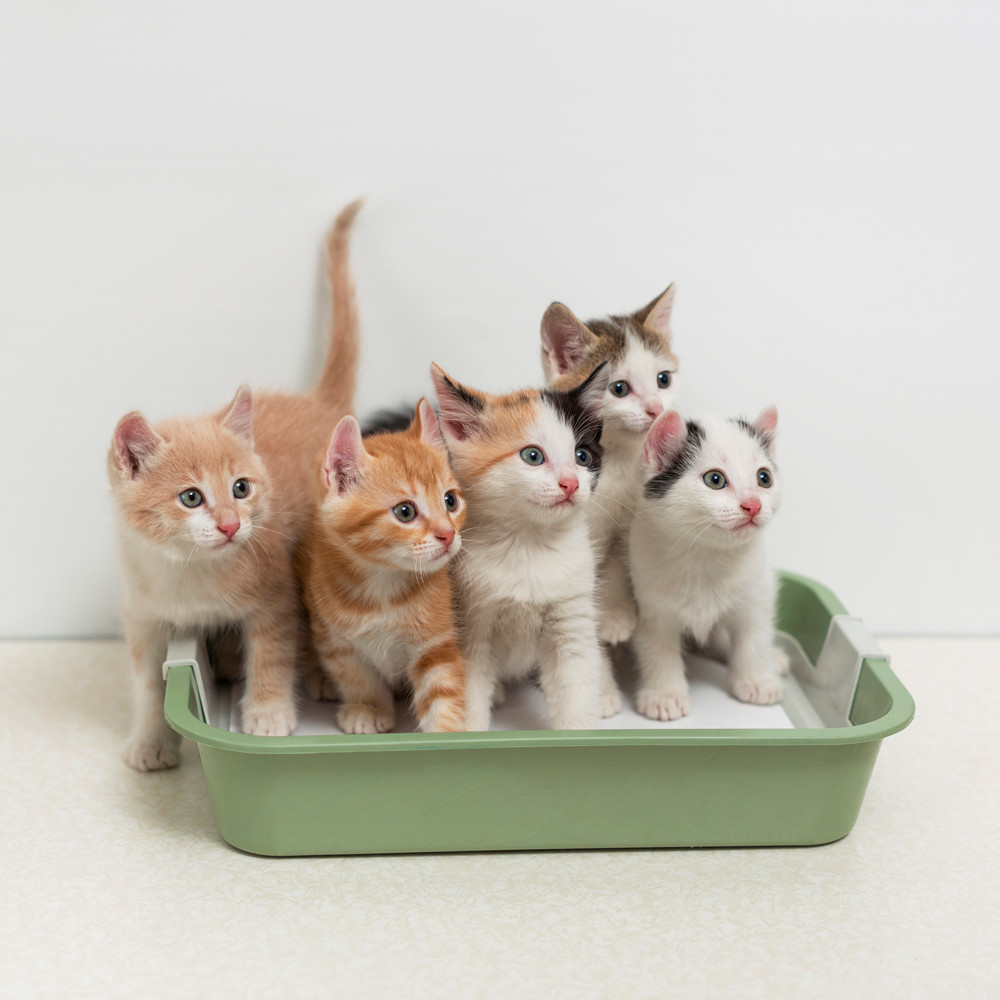Cat Clinic of Iowa City
Undesirable Elimination
Cat Clinic of Iowa City
A cat eliminating inappropriately can be frustrating. Read this helpful guide to help you through caring for your furry friend.
Educational Care Guides
Make caring for your cat easy!
There are 2 main types of undesirable elimination. The first is spraying or marking. Spraying is usually distinguished by stains on vertical surfaces, although you may notice the stain on the floor first. The second is squatting to urinate or defecate. Urination or defecation may take place on furniture or belongings as well as on the floor. Use of a black light helps locate all the areas where urination has occurred. All surfaces including furniture in all areas where a cat has access should be examined.
Spraying or marking on vertical surfaces
Spraying is not usually associated with any urinary health problem, although your vet should perform a urinalysis and examination to rule out any medical condition. Stress is the most common cause of spraying.
Urinating or defecating on horizontal surfaces
Litter box aversion may develop after an illness. These behaviors may also be caused by stress.
- Causes of stress may include:
- Change of people or animals in home
- Moving into a new home
- Home renovation or redecoration
- Restriction of movement inside the home or restriction of key resources like food, water, beds, and/or litter boxes
- Moving key resources to a new location
- Boarding or hospitalization
- Change in overall health
- Multiple cat households
- Inadequate environmental enrichment
- Inadequate opportunities to claim territory or “own” their home
- Social events or holidays
- Cats seen outside

* Cats do NOT eliminate outside the litter box out of spite, jealousy, or “anger”. These behaviors, although unpleasant to us, are natural for the cat. Preventing or resolving this normal feline behavior takes time and patience. Responding with a loud voice or clapping of hands or spraying with a water bottle only makes the environment more stressful. You will be frustrated, but your cat doesn’t recognize their behavior as “wrong”. They only perceive your reaction as unpleasant.
Treatment depends on the cause
Here are some suggestions for treatment.
- Neuter or spay your cat.
- Temporarily prevent the cat’s access to the areas sprayed. Gradually allow only supervised play in the areas he/she is spraying. The length of this seclusion depends on the desire of the cat to spray.
Create a deterrent by lining the area with tin foil, a plastic carpet runner with the nubby side facing up, or a mat covered in double-sided tape.
Deterrents should be temporary.
Move a litter box to the location or locations where the cat is eliminating. This may be a temporary or permanent change depending on the situation.
- Keep the floor and home uncluttered, especially if the cat is urinating on objects on the floor. Clutter can also be a source of stress as it doesn’t allow a clear line of sight through the room.
- If you plan to be out of town for a long period of time, board your cat or have a responsible caretaker stop in to feed him/her and scoop the litter box at least twice a day. This provides adequate interaction and reassurance that regular care and feeding continues even while you are gone.
- Don’t allow the cat to see or interact with strays outside. Prevent access by strays to the windows or yard with fencing, chicken wire placed on the ground, citrus scented sprays, or a motion-activated water sprayer.
- Intercat aggression: Introduce any new cat slowly to allow the existing cats to adjust to the scent, then the sight of their new housemate. If existing housemates are fighting, separate the cats and reintroduce them slowly. Do not leave cats alone together if fighting is occurring regularly.
- Increase environmental enrichment:
Increase access to the outdoors with a safe outdoor area called a “catio”.Play with all cats frequently and provide plenty of scratching posts and cat trees for fun and scent-marking. Play reduces anxiety and frustration in bored cats and increases confidence in shy or worried cats. Be creative with new enrichment items!
Provide plenty of beds and sleeping areas. These allow the cat to scent mark as well.
Feed the cat using food puzzles instead of from the bowl. Cats retain their innate desire to hunt prey. This practice allows a type of “hunting” and decreases anxiety and frustration associated with boredom and perceived food scarcity.
- Reassess your litter box situation:
Be sure there is at least 1 litter box per cat plus one extra, and at least 1 box per floor of your home. This is very important in multiple cat households to allow easy access to resources. Most cats prefer to urinate and defecate in different locations.Spread boxes throughout the home to allow this important type of scent marking.
Set your cat up for success! Make litter boxes accessible, i.e. where your cat spends most of its time. For kittens, senior cats, and cats with mobility problems, multiple litter boxes should be available to prevent accidents. The box should have a low opening to allow easy entry.
Most cats prefer an uncovered litter box at least 1.5 times the length of the cat. Jumbo is the smallest size you should ever purchase. Boxes may also be created from plastic storage boxes. We do not recommend using a litter box liner.
Replace most boxes once a year. Plastic absorbs odors. You may not smell it, but your cat does.Cats prefer scoopable unscented clay litter with low dust. Offer multiple options in a variety of boxes in multiple locations to learn your cat’s preference. If your cat had its claws amputated, the cat’s paws should be assessed for pain. Kitten Attract litter is a very soft litter option for painful cats. Cat Attract has helped some cats use the litter box more consistently. If your cat won’t use commercially available litter, be creative! Potty pads or towels may be your cat’s preferred “litter”.
Self-cleaning boxes are not recommended because they are difficult to clean and have a small usable area.
We do not recommend covered litter boxes, or “hiding” litter boxes in containers or closets unless this is where your cat is choosing to urinate or defecate. The cat may feel trapped in confined spaces. Small spaces also trap odors. Locate boxes in open areas with a clear line of sight through the room to prevent anxiety.
Keep the litter box clean! Scoop out daily. Discard old litter and disinfect boxes every 2 months, or more frequently in a multiple cat home or if a box is heavily used. Do not use heavily scented cleaners.
Keep the location of the box consistent and in a quiet area with no sudden disruptions. Allowing multiple escape routes is important in multiple cat homes to prevent a cat from feeling “trapped” in the box by another cat. A cat “sanctuary”, a room accessible only to the cat, may be necessary in homes with dogs or small children.
Clean sprayed areas thoroughly with a commercially available enzymatic product such as Simple Solution®, Nature’s Miracle®, Anti-Icky-Poo®, or Fizzion Pet Stain & Odor Remover®. Multiple applications will be necessary to remove the odor. After successfully removing the odor, you may clean with soap and water. Complete removal of odor is important to prevent repeated use of that location.
Use the Feliway® diffuser on all levels of your home. Feliway® Multicat is designed for multiple cat homes. It may take up to a month to see improvement with Feliway® use. If there are multiple areas – use Feliway® spray on all marked locations and use the appropriate Feliway® diffuser (regular vs. Multicat) on each level of the home.
Zylkene® is a supplement designed to reduce stress. It is mixed in with the food, and it may take up to a month to see improvement with Zylkene® use.
Royal Canin Calm® diet has multiple ingredients designed to have a calming effect. It may take up to a month to see improvement with the Calm® diet.
You may have to use several of these solutions at the same time.
Contact a feline behaviorist for personalized assistance in identifying causes and resolving undesirable behavior.
If none of these changes work, you may choose to talk to your vet about medication which may help your cat better manage stress.
A note for multiple cat households: Overcrowding is the most common cause of stress-related undesirable urination in multiple cat households. Cats living indoors do not form social groups. They are forced to share limited resources in a small living area with other cats, some of whom they may not get along with and are unable to avoid. Making all resources available throughout the home is necessary to prevent resource guarding. Providing plenty of activities in the form of toys, cat furniture, and outdoor enclosures (“catios”) or separating cats into smaller groups can minimize potential problems, but it is important to remember that as a household population grows so does the stress level. Some cats do not thrive in a multi-cat home and as a result may develop stress-related health problems such as urinary tract inflammation, or behavior problems such as undesirable urination. These cats often do well as single cats or in a household with one or two other cats with whom they get along well. Undesirable urination is often a behavior problem associated with a cat’s environment. Altering and improving the environment can resolve the problem.
Finally, this is very frustrating for any cat owner. If, after following all suggestions listed in this pamphlet, you are unable to create an environment in which your cat can be comfortable and stress-free, please contact us for help determining a further course of action which is best for you, your family, and your cat.
